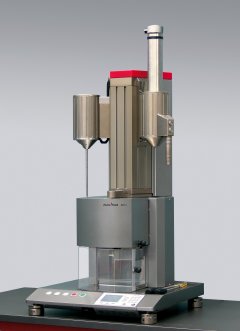Zwick's new Aflow extrusion plastometer was presented to industry specialists for the first time at the 18th testXpo international testing technology forum. "With this instrument we have demonstrated that new developments leading to significant improvements are possible even for really classical methods such as MFR/MVR determination," states Florian Liebert, who as product manager oversaw development of the new plastometer.
 State-of-the-art force-control, improved control of test load, pneumatic cleaning device and automatic parameter control are just a few of the key factors in the high level of operator convenience offered by the new Zwick Aflow extrusion plastometer.
State-of-the-art force-control, improved control of test load, pneumatic cleaning device and automatic parameter control are just a few of the key factors in the high level of operator convenience offered by the new Zwick Aflow extrusion plastometer.
A glance at Aflow confirms that it does indeed represent a new direction in melt index measurement. Designed for 50 kg test loads, the instrument presents a compact appearance. Florian Liebert explains: "This is basically because the instrument uses state-of-the-art force control in place of the usual individual weights. We have been installing force and position-controlled drives in testing machines at Zwick for many years and they are also commonly employed in rheometer construction. It seemed logical to apply this proven technology to high-quality extrusion plastometers as well."
The advantages of this technology are that it makes melt index determination significantly easier and more reliable. It offers the option of controlling the start position specified in the standards by means of superimposed force and speed control. At the start of measurement the instrument identifies the amount of polymer in the extrusion barrel and determines independently, on the basis of pre-set limit values, the load to be used in the pre-heating phase. This is a crucial advantage when polymers with unknown MFR are being tested, and also when operators have not adhered precisely to the specified charge quantity.
Load application via electromechanical drive provides greatly improved load control during the test. Weight application in classical instruments almost always involves percussive loadings; these are greatly reduced with Aflow. Multi-stage tests in particular, i.e. tests with various test loads, are largely impact-free using this instrument. Residual material at the end of the test can easily be extruded using the maximum test load of 50 kg, saving testing time.
The new Aflow is equipped with a pneumatic device for cleaning the extrusion barrel. This is a simple and fast two step process - the operator positions a cleaning pad and presses a button. Admittedly many polymers require the procedure to be repeated several times, but it is still considerably easier than manual cleaning.
This device can also be used for pre-compacting the test material directly after charging. The advantage is that pre-compacting is performed in a uniform manner, reducing operator influence and giving more consistent results.
Aflow has all the features of Zwick's existing product range, including automatic parameter control (APC), by which the optimum test parameters are determined and applied during the test. It also includes automatic bubble detection, which eliminates measurements distorted by air-bubbles.
The temperature in the extrusion barrel is generated by four heating elements, allowing Aflow to achieve a temperature accuracy of better than + 0.3°C over the relevant area of the barrel.
The instrument is usually controlled via a PC with testXpert II test software. Up to six Aflow and Mflow instruments can be managed and controlled by one PC. Highly operator-friendly stand-alone operation is also available, however.
"This instrument has been developed for testing-laboratories with a very high throughput, where testing is carried out continuously in three-shift operation. Here every movement counts and equipment must be highly robust and reliable in operation," is Florian Liebert's summary of the development concept behind the new product. It will also appeal to customers who simply appreciate the operating convenience which the new Aflow offers.